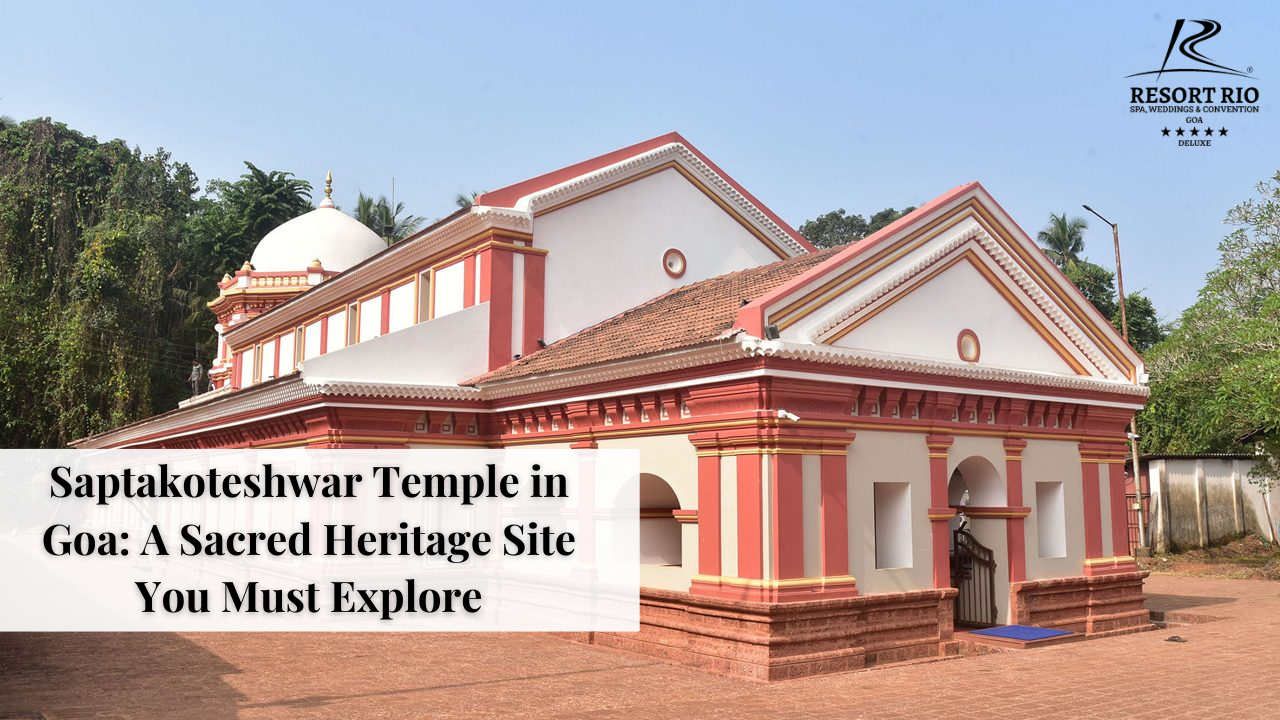Goa is usually associated with the golden beaches, nightlife, and delicious fresh seafood. Once you turn away from the coastline, you will see the other side of Goa. It is loaded with history, tradition, and spirituality. One such place to visit is the Saptakoteshwar Temple. This quiet shrine is a picturesque amalgam of cultural heritage. It is a place to worship and admire a timeless architecture.
Even today, the Saptakoteshwar Temple in Goa remains a hidden secret from these travelers who seek alternative versions of Goa with less beach and more parties.
Understanding the History of Saptakoteshwar Temple in Goa
Saptakoteshwar Temple is believed to have been built by the Kadambas in the 12th Century. Famed patrons of arts and culture, this temple stood as one of their finest works of art. Later, during the Portuguese period, the temple was destroyed. The Marathas, along with an earnest interest in patronizing Hindu shrines in the coastal area in the 17th century, reconstructed the temple.
So, through your presence today inside the temple, you are certainly not looking upon walls and engravings. You are a part of a throne sitting on centuries of history, aggrieved and rebuilt amid different sovereign powers. Hence, it stands as one of Goa’s celebrated heritage temples.
Where Is It Located?
This temple is situated in Narve, a small town about 35 km from Panaji. It is set away from the more active places of Goa; hence, it enjoys serenity. Coconut palm groves and serene villages have grown around, adding more calm to the temple’s vicinity.
The road transport facilities are good there. A part of the path is covered by local buses, but the majority prefer going by taxi from Panaji or renting a scooter if staying anywhere around. The road is quite scenic, winding through the corridors of Goan villages.
Meaning of Saptakoteshwar
In the word Saptakoteshwar, two parts are constitutive in Sanskrit. “Sapta” means seven, and “Koti” means crore. The combined meaning stands for “the Lord of seven crore.” Lord Shiva is worshipped here under this name. The temple was a far-flung temple of Shaivite worship in Goa and neighboring places.
To the Kadamba kings, Saptakoteshwar was a family deity. Traditionally, even to date, the local population holds the temple with great respect and visits it during festivals and auspicious times.
Temple Architecture
The austere architecture of the temple is attractive in its simplicity. While grandiose South Indian temples or those with pretty North Indian altars are a riot of color, the Saptakoteshwar Temple at Goa presents a more toned-down beauty.
Highlights are:
- Shikara (tower): The temple has a pyramidal tower, innocent in its modest tallness.
- Mandapa (hall): The hall is used by pilgrims to assemble for prayer.
- Stone Carvings: Not over-ornate, the carvings are neat and sharp.
- Deepastambha (lamp tower): A Slim lamp pillar outside enriches the building into a classic Goan temple.
Inside, the Shiva Linga stands center stage, being the focus of worship and rituals practised for generations daily.
Festivals at Saptakoteshwar Temple
Goa lights up when there is a festival in the city. It looks like a canvas with the brushstrokes of color and life. The primary festival celebrated here is Gokulashtami. Many devotees visit the temple and attend the cultural programs.
On the actual festival day, Mahashivratri, devotees flood the temple. On these days, the temple is beautifully decorated, with special prayers and a lovely traditional ambiance.
Things to Observe When You Go
In case you are planning to visit the Saptakoteshwar Temple in Goa, here are a few easy things to keep in mind.
- Dress modestly since this is a functioning place of worship.
- No photographs inside the sanctum, usually. Honor local traditions.
- Early morning or a similar time is ideal for a serene visit.
If you plan to go during the festival hour, then a wave of the crowd greets you with a very vibrant atmosphere.
Why It Matters Today
It is not only the temple’s history that lends prestige to this structure, but also its living presence that changes the course of Goan cultural life. Despite various changes that the area had undergone, the Saptakoteshwar Temple still shines as a religious light for the common folk.
This is another reminder that not all the heritage of Goa stands for Portuguese houses and churches. Goa has had thriving dynasties long before colonization, each giving us significant temples and cultural practices.
A Stop Worth Making
Tourists who venture off the beaches always claim that these secluded places are what make Goa rich. One such place is the Saptakoteshwar Temple in Goa, where history, spirituality, and phases of local culture are grounded rather deeply in reality.
A lot of beautiful views of Goa are seen while one is visiting this temple, along with staying in Panaji and some parts of North Goa. The drive to Narve is very serene, the village is quaint and welcoming, and the temple is mysteriously alluring.
Nearby Attractions
If you are already in Narve, you may also visit a couple of other places nearby:
- Mayem Lake: A Quiet lake for a short halt, about 8 km from this location.
- Chorao Island: Popular for its Bird Sanctuary, ferries sail from Ribandar.
- Divar Island: The scenic island near Narve, with old houses and churches.
Visiting these places along with the temple offers a nice mixture of nature and culture in Goa.
Final Thoughts
The Saptakoteshwar Temple in Goa is not the ostentatious kind. It is about experiencing life: of history, of religion, and of village life. The temple has weathered centuries of change and welcomes its visitors with great calm.
If ever you find time to go that far in Goa, away from its coastal beauties, do give yourself a treat by visiting the Saptakoteshwar Temple, Goa. This beautiful monument is a legacy that is meaningful not just to the native folks but to anyone interested in exploring the deeper aspects of this state.
After a day out in Narve, you can come back to the luxury of Resort Rio, one of the luxurious stays of Goa. With its large rooms, good food, and friendly hospitality, it is ideal for those who wish to experience both the cultural heritage and contemporary amenities of Goa.
Read More: Temples in Goa: A Guide to the Most Famous Goan Temples



